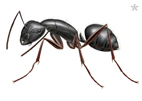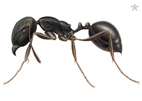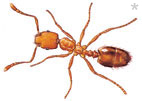Ants Pest Control
-
 Carpenter ants
Carpenter antsSize: Up to 1.58 cm long
Color: Varies from black, brown and black, red and black, to light brown depending on the species.The two most common pest species are black in color.
Biology: Carpenter ants are the largest ants found in British Columbia. There are two pest species of importance: the all-black carpenter ant (Camponotus modoc) and the reddish brown and black carpenter ant (Camponotus vicinus).
Damage: Carpenter ants can cause significant damage to homes and other structures, and should be exterminated at the earliest signs of infestation. Although Carpenter Ants do not eat wood, they excavate wood to make their nests, which consist of extensive networks of galleries often begun in areas soft from decaying wood
Behavior: Carpenter ants feed on a wide variety of foods, especially other insects. The favored food of adult ants is the sweet honeydew produced by plant-feeding insects, such as aphids, scales, and mealybugs. In the spring, mature colonies produce winged reproductive ants, called swarmers, that fly out to start new colonies. These swarms often occur from satellite colonies within homes, so homeowners may see large flying ants in their homes at night. Carpenter ants can be very difficult to control, so most homeowners employ the services of a professional company such as CanForce Pest Control.
-

-
Pavement Ants
Size: About 3 mm long.
Color: Brown.
Behavior: Pavement ant (Tetramorium caespitum) name is derived from its preference for nesting in soil next to and beneath slabs, sidewalks, patios, and driveways. Colonies are usually easy to find due to the piles of displaced soil next to and on top of pavement. Indoors, pavement ants nest under the foundation and within hollow block foundation walls. Occasionally, a colony may carry soil up into a wall to form a nest. When piles of soil appear from under baseboards or on top of a basement or garage floor, it is a good sign that pavement ants may be present.
Control: Individual pavement colonies can often be controlled using ant baits, but perimeter inspection and treatment are commonly necessary for long-term relief.
-

Pharaoh Ants
Size: Very small, about 1-3 mm in length and may easily be confused with several other types of pest ants.
Color: Yellow
Behavior: This pest ant can be very difficult to control and eliminate. When foraging worker ants are killed by residual treatments, the colony will fracture or split into two or more colonies to ensure part of the colony survives. If such treatments are continued, the infestation is spread throughout the building. Pharaoh ants typically establish themselves in areas near moisture, such as the kitchen or bathroom. They travel from room to room within the walls via plumbing pipes and electrical wires.
Habitats: Pharaoh ants (Monomorium pharaonis)will nest in virtually any site that provides protection. Colonies have been found nesting in walls, furniture and appliances, but they have also been discovered in unique locations such as between the folds of sheets in closets, hollow curtain rods, inside irons, in small boxes and under roofing shingles. They are extremely opportunistic in their selection of nesting sites
Control: Pharaoh ants can only be controlled by effective placement of ant baits. The type of bait that is ultimately successful is one on which the colony or colonies involved will feed for an extended period of time. The foraging workers return the bait to the colony, feeding it to other workers, larvae and queens.
Call us today for EXPRESS FREE QUOTE at 604-726-4900
For professional pest control in
Burnaby, Vancouver, Coquitlam, Port Moody, North Vancouver, Richmond,
West Vancouver, Ladner, Tsawwassen, Maple Ridge, Surrey, Langley, Abbotsford, Mission, Lions Bay, Chilliwack, White Rock , New Westminster, Port Coquitlam
